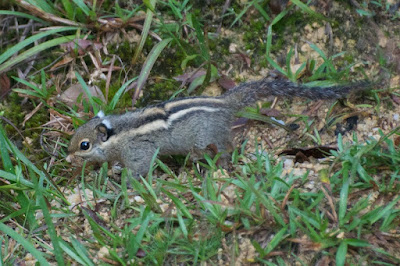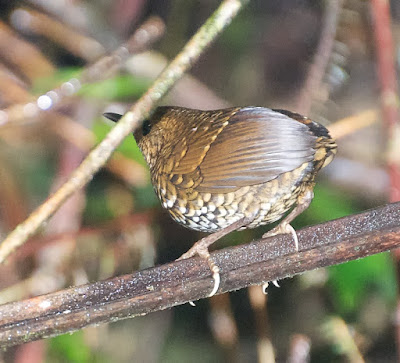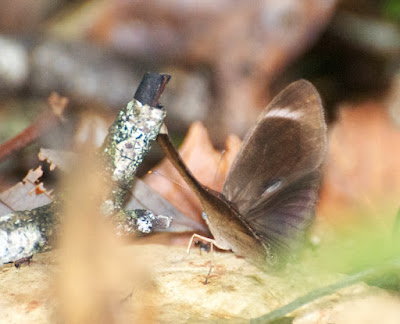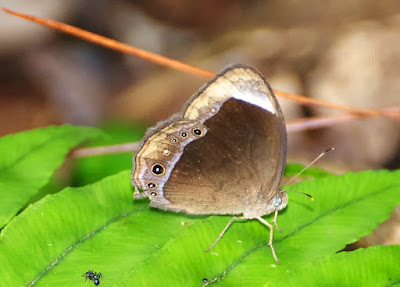Our ostensible goal was a supposedly-cooperative Malayan Whistling Thrush (Myophonus robinsoni), which of course didn't show up - too many Sunday visitors, plus an early start to the rainy season that provided our water-loving target with lots of places to go that were not by busy, crowded roadsides. When we arrived at its chief hangout, a tiny stream rippling down a
forested hillside on the ascent road, there was nothing to be seen but
an adult and an immature Rufous-browed Flycatcher (Anthipes solitaris).
Yes, I know, the guidebooks still call this Ficedula solitaris, but molecular studies have shown that it and its close relative the White-gorgeted Flycatcher (Anthipes monileger) are actually closer to another group of flycatchers, the niltavas, than to the other Ficedulas).
Yes, I know, the guidebooks still call this Ficedula solitaris, but molecular studies have shown that it and its close relative the White-gorgeted Flycatcher (Anthipes monileger) are actually closer to another group of flycatchers, the niltavas, than to the other Ficedulas).
Seeing these little birds, of course, was no bad thing. The Rufous-browed is a delightful creature, favoring low perches where it can be watched without the eye-craning many flycatchers seem to demand. These two were particularly tame (presumably because birders anxious to lure out the whistling thrush had been liberally supplying the area with mealworms). Here is the adult, one of those birds that seems designed to evoke a thoroughly unscientific 'aaaww' from its observers.
Once we had satisfied ourselves that the whistling thrush was not going to put in an appearance, we headed on to the usual first target for birders on the hill, the parking lot at the Jelai Inn. This used to be an almost mandatory stop, where you could get close looks at all kinds of birds dropping by to feast on the moths attracted to the lights at night and still around in the morning. The inn, though, has been long closed, and it seems that no one is turning the lights on any more. We were lucky enough, though, to find that a family of local birders (newbies who were quite delighted to meet (Bing) camping in the parking lot had put out a bit of bread. The bread didn't draw the usual crowds, but it did pull in this Long-tailed Sibia (Heterophasia picaoides)...
...and another highland specialty, a Chestnut-capped Laughingthrush (Garrulax mitratus or Ianthocincla mitrata, depending on which taxonomy you prefer).
It also attracted the local (though more arboreal) answer to our North American chipmunks, a Western, or Himalayan, Striped Squirrel (Tamiops mcclellandii).
It made repeated dashes to the hoard of bread, grabbing a mouthful each time and scurrying off before returning for another bite.
It made repeated dashes to the hoard of bread, grabbing a mouthful each time and scurrying off before returning for another bite.
This Grey-bellied Squirrel (Callosciurus caniceps), sitting quietly in a bush munching its hoard, was considerably more sedate.
The best bird of the day, at least as far as I was concerned, turned up later. While Bing was investigating a densely-vegetated roadside, a tiny bird hopped out directly in front of her. It was a Pygmy Wren-Babbler (Pnoepyga pusilla), normally a mouse-like skulker in the undergrowth (and a lifer for me, though I had at times glimpsed tiny brown birds darting from under my feet that might have been Pygmy Wren-Babblers).
This one, though, wouldn't leave us alone; apparently it, too, had learned that eager birders (not us) might be willing to bribe it with food. Pygmy Wren-Babblers come in two colour morphs, either whitish or chestnut-buff on the underparts; this is a light-morph bird. It even sang at us (a high-pitched, sibilant monotone whistle, if you must know). It was an active little creature, though, keeping as much as possible to the undergrowth, and my attempts to get a decent photo usually ended up being portraits of patches of dirt where the bird had just been.
This photo demonstrates two of the Pygmy Wren-Babbler's chief features: a nearly nonexistent tail, and short, rounded wings that seem to enclose the bird's body like a pair if cupped hands. The name Pnoepyga literally means 'cupped wing', and we really ought to be calling this bird and its three or four congeners 'cupwings' instead of wren-babblers. We always knew they were not wrens (though they certainly recall some of the more tiny and secretive members of that family), but recent DNA work has shown that they are not babblers either. Instead, Pnoepyga represents an early offshoot of the entire babbler-Old World warbler assemblage. The genus has now been placed in its own family, Pnoepygidae. You may therefore start calling this bird a Pygmy Cupwing if you like; it will undoubtedly start bearing that name in upcoming checklists and field guides.
By the way, the other birds (outside of Pnoepyga) that bear the name 'wren-babbler' are still considered genuine babblers - with the sole exception of the Spotted Wren-Babbler (Elachura formosa), an obscure little bird found from China to India which seems to be the sole survivor of yet another ancient lineage. It is now the only member of another new family, the Elachuridae.
After the Wren-Babbler, or Cupwing, or whatever we ought to call it, other birds seemed almost an anticlimax - which goes to show you how taxonomists can catapult an otherwise unobtrusive little brown job into birding prominence. Not that the other birds weren't worth seeing - I'm saving the most colourful for Part 3 of this writeup, but in the meantime I can tell you that we had nice, if not close, looks at montane pigeons like this Little Cuckoo Dove (Macropygia ruficeps)...
...and this even more far-off Mountain imperial Pigeon (Ducula badia).
We were treated to a nice fly-by by this Crested Serpent Eagle (Spilornis cheela), perhaps the most frequently-seen of forest raptors.
At the other end of the size scale, we found a female Black-throated Sunbird (Aethopyga saturata) investigating a clump of lantana.
Female sunbirds are a lot tougher to identify than males, but the Black-throated's yellow rump is certainly a help.
Long-billed Spiderhunters (Arachnothera robusta) are less interested in flowers than are their smaller sunbird cousins. Sorry about the leaf crossing the bill.
The spiderhunter's chief interest was undoubtedly ] insects, an interest we shared (but, obviously, for different reasons). This Leopard Lacewing (Cethosia cyane) caught my eye, but neglected to pose properly for my camera. Cethosia butterflies, of which there are several species in Southeast Asia, are interesting as well as beautiful creatures; no one has ever agreed on exactly what their relationships are, though they are usually associated, if distantly, with the Heliconiinae, as subfamily of brush-footed butterflies (Nymphalidae) including the colourful longwings (Heliconius) of the New World tropics (and of almost every butterfly house on the planet, often along with a Cethosia or two).
Much less gaudy was this White-bar Bushbrown (Mycalesis anaxias), a species with an oddly scattered range including southwestern India, the eastern Himalayas and Peninsular Malaysia.
Bushbrowns, like a number of other largely brown butterflies, spend most of their time on or near the forest floor. Like many other Mycalesis species, this butterfly comes in wet-season and dry-season forms (though telling the wet and dry seasons apart is becoming increasingly difficult in Malaysia); this appears to be the wet-season form, with clearly marked eyespots, or ocelli, along the edge of the hindwing.
As my readers presumably know, I always keep an eye out for dragonflies. This was my first encounter in Malaysia with Orthetrum triangulare, a species with a scattered range in highland areas through much of tropical Asia. I had seen it previously in China.
Sometimes. of course, the insects come looking for you. Undoubtedly a sweat-stained boot is a first-rate resource for a butterfly, such as this Vagrant (Vagrans egista macromalayana), on the hunt for mineral salts.
...and this even more far-off Mountain imperial Pigeon (Ducula badia).
We were treated to a nice fly-by by this Crested Serpent Eagle (Spilornis cheela), perhaps the most frequently-seen of forest raptors.
At the other end of the size scale, we found a female Black-throated Sunbird (Aethopyga saturata) investigating a clump of lantana.
Female sunbirds are a lot tougher to identify than males, but the Black-throated's yellow rump is certainly a help.
Long-billed Spiderhunters (Arachnothera robusta) are less interested in flowers than are their smaller sunbird cousins. Sorry about the leaf crossing the bill.
The spiderhunter's chief interest was undoubtedly ] insects, an interest we shared (but, obviously, for different reasons). This Leopard Lacewing (Cethosia cyane) caught my eye, but neglected to pose properly for my camera. Cethosia butterflies, of which there are several species in Southeast Asia, are interesting as well as beautiful creatures; no one has ever agreed on exactly what their relationships are, though they are usually associated, if distantly, with the Heliconiinae, as subfamily of brush-footed butterflies (Nymphalidae) including the colourful longwings (Heliconius) of the New World tropics (and of almost every butterfly house on the planet, often along with a Cethosia or two).
Much less gaudy was this White-bar Bushbrown (Mycalesis anaxias), a species with an oddly scattered range including southwestern India, the eastern Himalayas and Peninsular Malaysia.
Bushbrowns, like a number of other largely brown butterflies, spend most of their time on or near the forest floor. Like many other Mycalesis species, this butterfly comes in wet-season and dry-season forms (though telling the wet and dry seasons apart is becoming increasingly difficult in Malaysia); this appears to be the wet-season form, with clearly marked eyespots, or ocelli, along the edge of the hindwing.
As my readers presumably know, I always keep an eye out for dragonflies. This was my first encounter in Malaysia with Orthetrum triangulare, a species with a scattered range in highland areas through much of tropical Asia. I had seen it previously in China.
Sometimes. of course, the insects come looking for you. Undoubtedly a sweat-stained boot is a first-rate resource for a butterfly, such as this Vagrant (Vagrans egista macromalayana), on the hunt for mineral salts.



































No comments:
Post a Comment